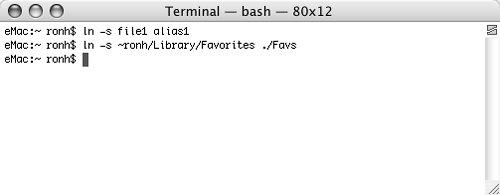Making Symbolic Links with ln
| Mac OS enables you to make aliases to files. It should come as no surprise that Unix does, too. But in Unix, aliases are called symbolic links. And rather than use a menu command or shortcut key to create them, you use the ln (make links) command with its -s option.
To make a link to a fileType ln -s source-file target-file and press Figure 23. These examples show the commands for creating symbolic links to a file and a directory.
For example, ln -s file1 alias1 creates an alias called alias1 that points to the file called file1. In this example, both files (the source and the target) are in the current directory. To make a link to a directoryType ln -s source-directory target-file and press For example, ln -s ~ronh/Library/Favorites ./Favs creates a alias called Favs in the current directory (./) that points to the directory called Favorites, which is in the directory called Library, inside the home directory (~) of the user ronh. |
EAN: 2147483647
Pages: 301
 Tips
Tips